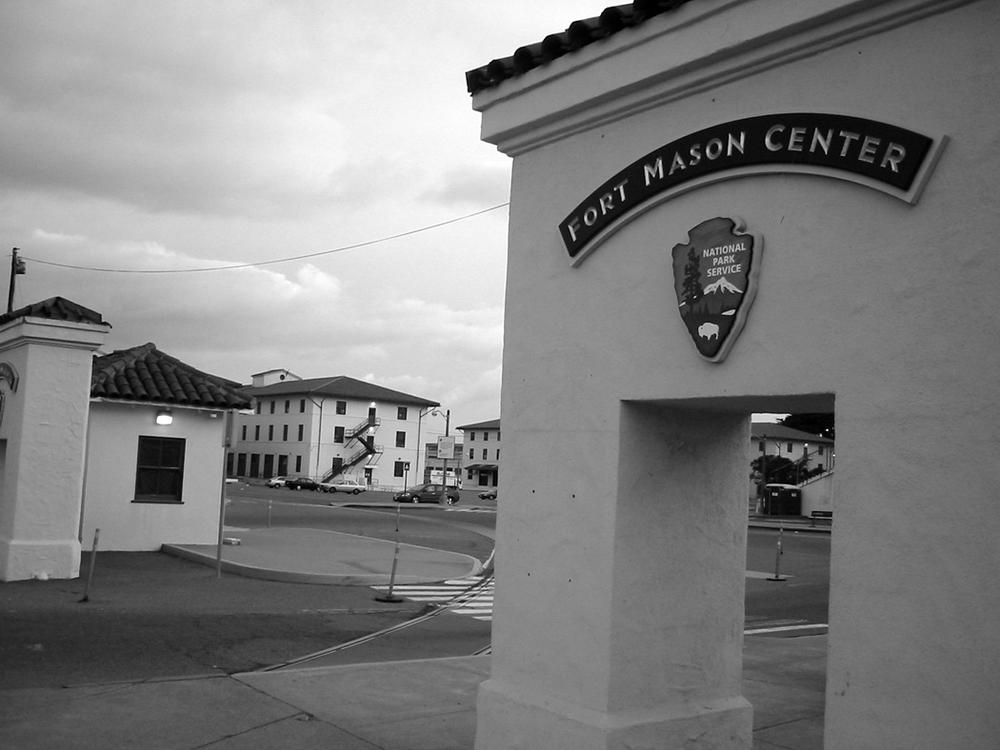Confessions of a Public Speaker (4 page)
Read Confessions of a Public Speaker Online
Authors: Scott Berkun
Tags: #BUSINESS & ECONOMICS / Skills


It’s 7:47 a.m. at Fisherman’s Wharf in San Francisco, so early the
sun is just starting to rise. It’s an ungodly time and place for any
writer to be outside. Writers aren’t the most well-adjusted people, and
it’s telling that our preferred means of interaction with civilization is
throwing paragraph-shaped grenades at people from behind the safety of a
laptop. I know few writers who love mornings, and the doorman at my
hotel—who wears a bright blue sailor’s uniform as part of the
nautical-themed thrill ride that is the Argonaut Hotel—is clearly on my
side. He waves down a cab for me and gives a half-smile from underneath
his tired eyes, a smile that says, “Doesn’t it suck to work this early?”
Anyone who finishes the night shift with a sense of humor is a good man
indeed. Or perhaps I just look like trash this morning and he finds my
appearance entertaining. Maybe it’s both.
People talk about sunrises as if they were magical things. Yet here
at Fisherman’s Wharf, the morning fog forming a glorious orange blanket
around a late-winter sunrise, no one except the doorman, the cab driver,
and me is awake and outside. You know why? People are lazy. Even if there
was a sunrise at 7:47 a.m. as brilliant and soul-stirring as a wall-sized
J. M. W. Turner masterpiece, a sunrise giving out $100 bills and
tomorrow’s lottery numbers, few of us would be out to see it. Most of the
things we say are so wonderful and amazing will lose without a fight to an
extra hour of sleep. We’d wake up, think it over for a few moments, and
fall back into the comfort of our dreams. Sleep deprivation is a curse of
the modern age, a problem born from our technological things. Before
Edison’s light bulb, we averaged 10 hours a night; in 2009, we average
nearly half that.
[
13
]
And this means, when it comes to sunrises, judge people by
what they do, not what they say.
On this morning, the sun is putting on quite a show, but where are
all the sunrise-lovers? They’re not with me out on the street. They’re
sleeping, just as I would be if I could. The truth is, public speakers
everywhere would have an easier time keeping their audiences awake if more
people actually slept well the night before. If the ascension of our
nearest star—the source of all energy and life on earth, the universal
symbol for all that is good, happy, and hopeful—can’t get people out of
bed, what chance does a speaker have?
In all honesty, I love the sunrise…it’s the getting up to see it I
hate. Sunrises are transcendent when viewed through a hotel window, from a
comfy bed, when I’m not expected to do anything for anyone for hours. My
professional problem is that public speaking is often scheduled hundreds
of minutes on the wrong side of noon. And on the days I’m lucky enough to
get top billing for an event, I earn an additional chronological treat:
the keynote means I’m to set the tone for the day, a challenge that—given
our limited understanding of space and time—requires me to speak before
anyone else. All this explains why, at 7:48 a.m. on a Tuesday, I am
showered, cleaned, shaved, pruned, fed, and deodorized, wearing a pressed
shirt and shiny shoes, in a cab on my way to the San Francisco waterfront.
Like the gorgeous light from the sun still conquering the clouds over the
San Francisco Bay outside my cab window, this morning is both great and
horrible, a thrill and a bore. It’s an amazing way to live, getting paid
to think and learn and exchange ideas—all things I love. But I’m far from
home, going to an unfamiliar place, and performing for strangers, three
stressful facts that mean anything can happen, especially since it’s the
worst of all times for my particular brain—early morning.
Making it to the venue is the first challenge a speaker-for-hire
faces, and let me tell you, it’s often a bigger challenge than the lecture
itself. The lecture I know well, since I created it. I have no one to
blame if it stinks. And when I do finally arrive at the room I’m to speak
in—even if it’s the worst room in the world—I can try to adapt to whatever
problems it has. But until I get to the room, until I make my way through
the airports, highways, cities, conference centers, office complexes, and
parking lots, I can’t begin to get ready. Being in transit means,
psychologically speaking, you are in the purgatory of being
almost
there. Unlike lecturing, where I feel in
control, it’s the things I can’t control that create stress—like the taxi
driver getting lost, the traffic jam a handful of miles from where I’m
supposed to be, and the confusing corporate and college campuses
impossible for visitors like me to navigate. (How could anyone know
Building 11 is next to Building 24 on Microsoft’s main campus, or that the
Kresge Auditorium is hiding behind Bexley Hall at MIT?) From experience, I
know there is nothing worse than being in the strange territory of very
close and surprisingly far at the same time.
When I arrive at the Fort Mason complex, the venue for this
particular Tuesday, I discover, as my taxi roars off, that I’m far from
where I need to be. Fort Mason is a sprawling Civil War–era military base,
recently converted into a community center. The word
complex
is apt. My instructions say to find Building
A, but there are no signs, and, more importantly, no normal-looking
buildings, only endless rows of identical barracks, towers, and narrow
parking lots (see
Figure 3-1
). The Fort Mason
Center has one major flaw: it skipped the conversion. It still looks like
a place designed to kill you, not welcome you to fun community activities.
There are fences, gates, barricades, barbed wire, and tall stone walls
with sharp corners.

Figure 3-1. The speaking venue: the intimidating Fort Mason, San
Francisco.
For comparison, there’s a military museum in Kiev with two
decommissioned World War II tanks at the main entrance, painted top to
bottom with fun, peaceful swirls in bright rainbow colors (see
Figure 3-2
). Now that’s a
conversion: one day a death machine, the next a happy, silly plaything.
Fort Mason, on the other hand, looks like a place the Spartans would say
is too spartan. They’d demand a row of shrubs and fresh paint
before they’d even consider moving in.

Figure 3-2. The National War Museum in Kiev, Ukraine. This is how to renovate
a thing made for war.
Trying to find my way, I stop at the front gate—which is what I do
instinctively at gates near things looking like military bases—and only
after long moments standing like an idiot do I realize I’m free to enter.
No ID or white flag required. The gate is for cars, which explains the
strange look from the guard: I’d been standing in the car lane the entire
time. I wander aimlessly through the complex, surviving several dead ends,
wrong turns, and unlabeled parking lots, trying not to imagine snipers in
the towers above, until I find Building A and happily step inside.
The event at Fort Mason was run by Adaptive Path, a well-known Bay
Area design consulting company, and I know these folks well. They’ve hired
me before, and I say hello to friendly faces. I soon meet Julie, one of
the event organizers, and after a brief chat she hands me an envelope. I
know that inside is a check for $5,000, the fee for my services. I want to
open it and look. My brain still thinks like a kid in terms of money,
where $100 is tons and $500 is amazing. Anything over that simply does not
exist in the surprisingly large 15-year-old part of my mind. I want to
look inside, not because I don’t trust Julie, but because I don’t trust
myself. I’m baffled at how adults pay other adults so much
for doing boring, safe, adult things. My childhood friend
Doug drove his mom’s Cadillac over the big hill on the wrong side of the
entrance to the Whitestone Shopping Center in Queens at 60 miles per
hour—with all of us screaming in the back seat—for free. He risked all of
our lives without payment, other than his own insane but infectious
pleasure. Meanwhile, bankers and hedge fund managers make millions playing
with Excel spreadsheets, an activity with zero chance of bodily harm, save
carpal tunnel syndrome. They earn more in a year than the guys who put the
roof on my house, paved the road that leads to it, or work as firemen and
policemen to protect it will see in a lifetime. It’s curious facts like
these we’ll have to explain twice when the aliens land.
In the movies, gangsters are always opening briefcases and counting
money, but in real life, no one does this. It’s awkward, strange, and
slimy. Money for Americans, a culture cursed by our unshakable Puritanical
roots, is loaded with lust and shame. Yet, our modern consumer culture
values the accumulation of financial wealth above all else, despite that
little line of scripture about camels and needles suggesting that, for the
faithful, this might be a bad idea.
[
14
]
The resulting contradiction causes much of what’s wonderful
and horrible about America. I suspect many of you jumped right to this
chapter because of its title, or noticed it first when you skimmed through
the table of contents. Not because you’re evil, but because we’re
simultaneously fascinated and revolted by money, especially regarding work
that seems superficial, like public speaking. I know I’m paid for
something that, in the grand scheme, is not Work. It’s work, with a little
w
, but it’s not shoveling coal, building houses, or
fighting in wars, which earn the capital
W
. I will
never hurt my back, ruin my lungs, or get shot (unless I give a lecture at
the next gang fight in the South Bronx). And despite the many questions
that come to mind when Julie hands me that check, I cram it into my bag
and head for the lectern where I can get to work.
I’m worth $5,000 a lecture and other speakers are worth $30,000 or
more for two reasons: the lecture circuit and free market
economics.
[
15
]
People come up after I give a lecture and ask, “So when did
you get on the
lecture circuit?” And I respond by asking, “Do you know what
the circuit is?” And they never have any idea. It’s a term they’ve heard
before, despite the fact that it’s never explained, and it somehow seems
to be the only reasonable thing to ask a public speaker when you’re trying
to seem interested in what he does for a living. Well, here’s the primer.
Public speaking, as a professional activity, became popular in the U.S.
before the Civil War. In the 1800s—decades before electricity, radio,
movies, television, the Internet, or automobiles—entertainment was hard to
find. It explains why so many people sang in church choirs, read books, or
actually
talked
to one another for hours on end:
there was no competition.
In the 1820s, a man named Josiah
Holbrook developed the idea of a lecture series called
Lyceum, named after the Greek theater where Aristotle
lectured his students (for free). It was amazingly popular, the
American Idol
of its day. People everywhere wanted
it to come to their town. By 1835, there were 3,000 of these events spread
across the United States, primarily in New England. In 1867, some groups
joined to form the Associated Literary Society, which booked speakers on a
singular, prescribed route from city to city across the country. This is
the ubiquitous lecture circuit we hear people refer to all the time. Back
then it was a singular thing you could get on. “Bye, honey, I’m going on
the circuit…be back in six months,” was something a famous lecturer might
have said. It took that long to run the circuit across the country on
horses and return home. Before the days of the Rolling Stones or U2, there
were performers who survived the grueling months-long tours without
double-decker tour buses, throngs of groupies, and all-hour
parties.
